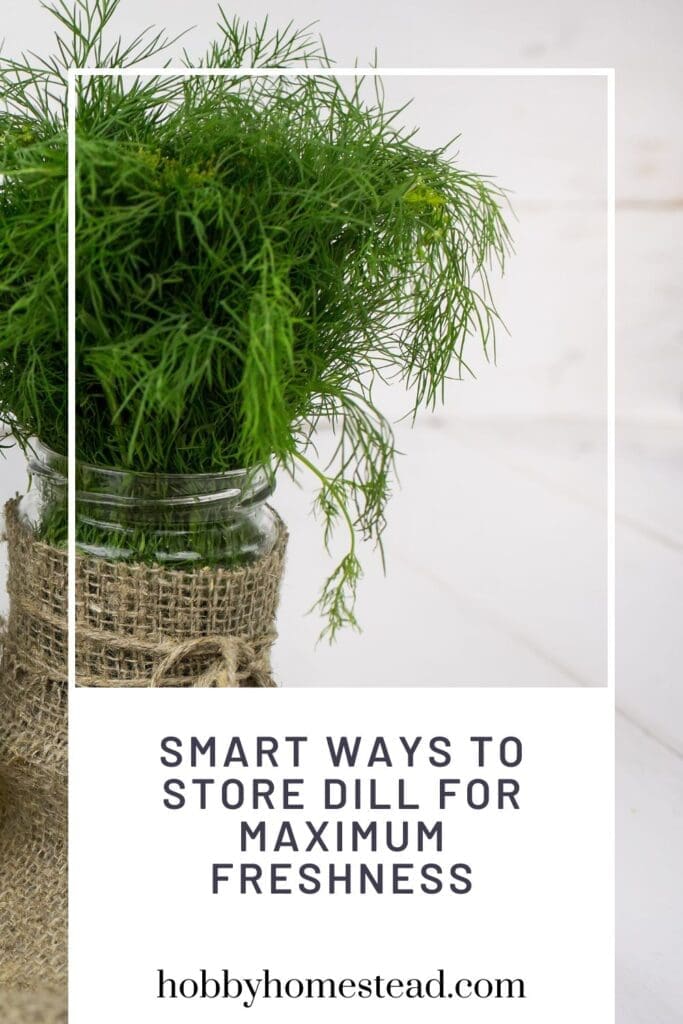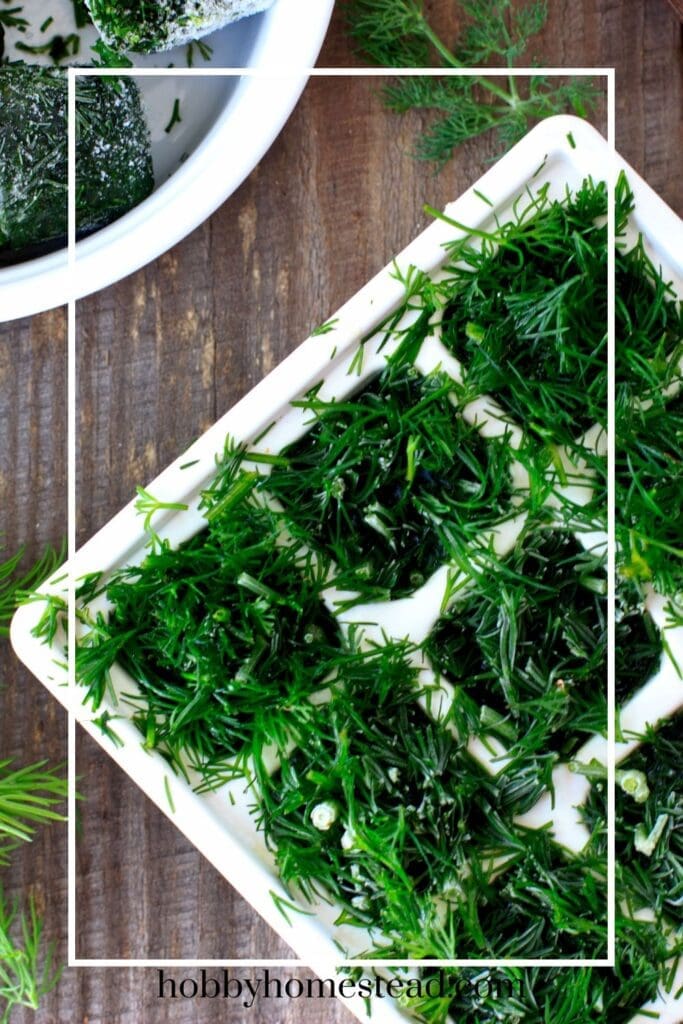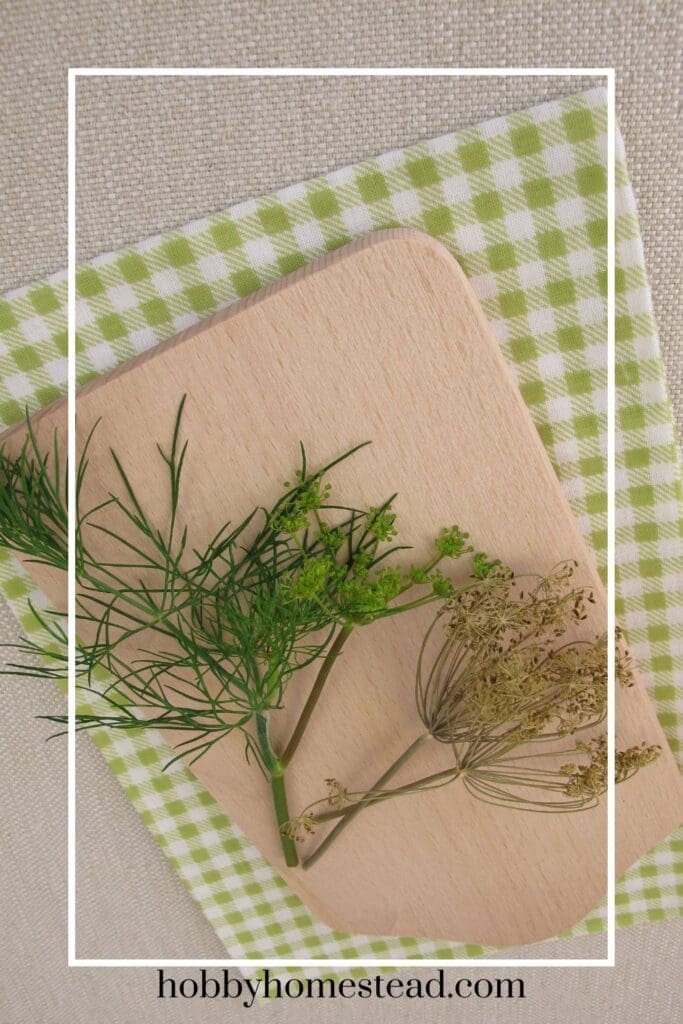It always seems the dill is ready before my produce from my garden, so how do I store dill, so I have it for recipes and canning. Fresh dill is one of those aromatic herbs that brings bright, tangy flavor to everything from chicken salad to dill pickles.
This works for fresh dill from the grocery store or harvested dill plants from your own garden. So, how should you store it to keep that signature flavor as long as possible.
The good news? There are several easy methods for storing dill, whether you want to keep it fresh for a week, dry it for long-term storage, or even freeze it in ice cube trays for future use.
This post will walk you through the best ways to store dill leaves, dill heads, and even dill seeds, so nothing goes to waste.

First Things First: Choosing the Best Dill
Whether you’re growing your own dill (Anethum graveolens) or buying it, look for bright green dill fronds with no signs of wilting or yellowing.
If harvesting from your herb garden, the best time to gather delicate herbs like dill is in the morning after the dew has dried but before the sun gets too hot.
This preserves the essential oils for the best flavor and aroma.
How to Store Fresh Dill in the Fridge
To store fresh dill for maximum fridge life, the goal is to reduce excess moisture while keeping the herb hydrated.
Method 1: Damp Paper Towel + Plastic Bag
- Rinse dill leaves gently in cold water to remove dirt.
- Pat dry using paper towels or a salad spinner to remove as much water as possible.
- Wrap the dill in a damp paper towel, then place it inside a plastic bag or freezer-safe bag.
- Store in the crisper drawer of your fridge.
This method can help fresh dill weed stay fresh for up to 7 days.
Method 2: Standing in Water (Just Like Flowers!)
- Trim the stems and place the bunch in a glass jar with just enough water to cover the ends.
- Loosely cover the top with plastic wrap or a plastic bag to trap humidity.
- Store in the fridge, changing the water every couple of days.
This is a great way to store delicate leaves while preserving the best flavor.

Freezing Dill for Long-Term Storage
If you want dill to last a long time, freezing is the way to go. Frozen dill doesn’t stay crisp, but it retains its flavor beautifully.
Easy Ways to Freeze Dill:
Option 1: Whole or Chopped Dill
- Wash and dry dill fronds thoroughly.
- Chop into smaller pieces or freeze whole.
- Pack into a freezer bag, removing as much air as possible to prevent freezer burn.
Option 2: Ice Cube Trays with Olive Oil or Water
- Mince fresh dill and place it in ice cube trays.
- Cover with olive oil or cool water and freeze.
- Once frozen, transfer cubes to airtight containers or freezer-safe bags for up to 6 months.
This method is a great option for adding dill to soups, sauces, and recipes like a creamy dill dip or a pickling recipe.
Frozen Dill Ice Cubes: A Flavor Saver for Future Meals
One of the easiest ways to preserve fresh dill is by freezing it in ice cube trays. Perfect for adding to soups, stews, and sauces later on. Here’s how to do it:
- Rinse the dill fronds in cool water and pat them dry with paper towels or a salad spinner.
- Chop the dill into smaller pieces and pack it into each compartment of an ice cube tray.
- Fill the compartments with either cold water or olive oil, just enough to cover the herbs.
- Freeze until solid, then transfer the cubes to a freezer-safe bag or airtight container.
- Label with the date and type of herb for future use.
This method locks in the essential oils and helps preserve the intensity of flavor, making dill cubes a great addition to dishes like creamy sauces, marinades, or even a quick dill butter for green beans or roasted vegetables.

Drying Dill for Shelf-Stable Storage
Drying dill is ideal when you have larger quantities from a big dill harvest. This method helps preserve the flavor of this annual herb for a long time and makes it easy to store.
Best Methods for Drying Dill:
1. Air Drying
- Tie small bundles of dill with a rubber band and hang upside down in a well-ventilated area out of direct sunlight.
- You can also place sprigs in a brown paper bag with holes punched in it for air circulation and to catch falling leaves.
2. Oven or Dehydrator
- Lay dill in a single layer on a cookie sheet lined with parchment paper.
- Dry in an oven set to the lowest room temperature setting (around 100–110°F) with the door slightly open.
- This drying process can take a few hours.
Once dry, crumble the leaves and store them in an airtight jar or glass container in a dark place like a pantry.
Note. Dry dill is more concentrated than fresh, so use about 1 teaspoon of dried herb in place of 1 tablespoon of fresh.
What About Dill Seeds and Flowers?
Dill flower heads and ripe seed heads are the best part for those making classic dill pickles or saving seed for the next season.
- Let dill flowers fully set seed on the plant before harvesting.
- Once they are brown and dry on the stem, snip the heads and let them dry further in a dry place.
- Rub the heads over a large bowl to collect seeds.
- Store dill seeds in small containers or airtight jars in a cool, dry spot.
Dill seeds have many benefits and are a great addition to pickling spice blends or teas.
Final Tips for Success
- Avoid storing dill near apples, bananas, or other ethylene-producing fruits like avocados, peaches, and tomatoes. These fruits release a natural gas called ethylene that speeds up ripening—and in the case of delicate herbs like dill, it can cause them to wilt and spoil much faster. For maximum freshness, keep dill in its own space away from these items. They speed up wilting.
- Store dried or frozen dill in labeled containers for accuracy of any cited facts and easy use later.
- Dill is a tender herb, so handle gently to avoid bruising.
- If you’re drying or freezing dill for future use, aim to capture the intensity of flavor at its peak.
How to Tell If Dill Has Gone Bad
Even with proper storage, fresh dill won’t last forever. Here’s how to spot dill that’s past its prime:
- Wilted or slimy leaves. If the delicate leaves are limp, slimy, or mushy, it’s time to toss them.
- Yellow or brown discoloration. Bright green is best. If the dill has turned dull, yellow, or brown, it’s lost its best flavor and freshness.
- Off smell. Fresh dill should have a strong, fresh, slightly sweet aroma. A sour or musty smell means it has gone bad.
- Excess moisture. If you see condensation or soggy spots in the plastic bag or container, the dill may spoil faster due to trapped moisture.
Tip. For dried or frozen dill, check for freezer burn, faded color, or lack of aroma—these are signs it’s time to replace it with a fresher batch.
Ready to Take Your Dill to the Next Level?
You can now dry dill from your own garden, freeze it from a big harvest, or just make a grocery store bunch last the week. These easy ways to store dill will help you reduce waste, save money, and enjoy this easy herb in everything from roasted green beans to creamy sauces and pickles.


